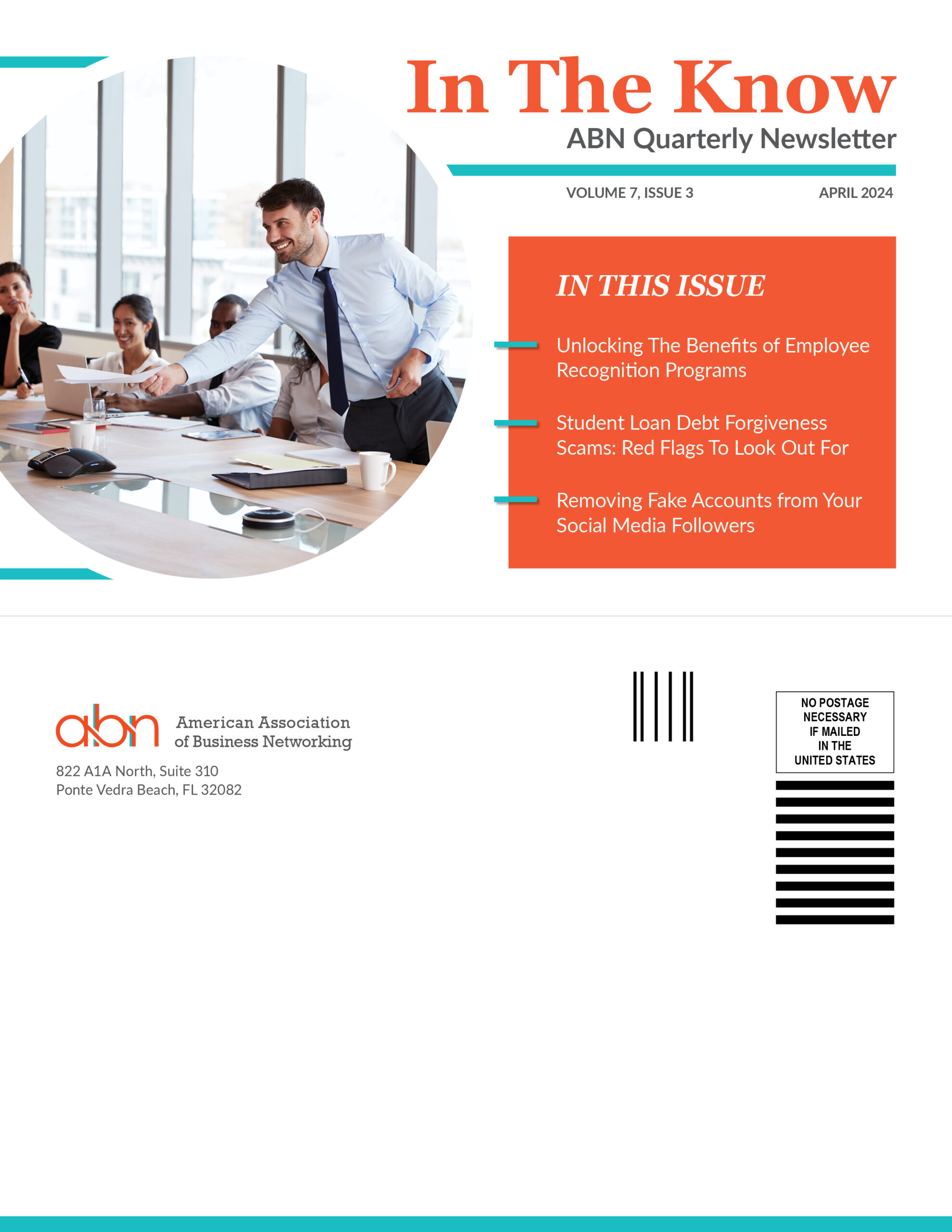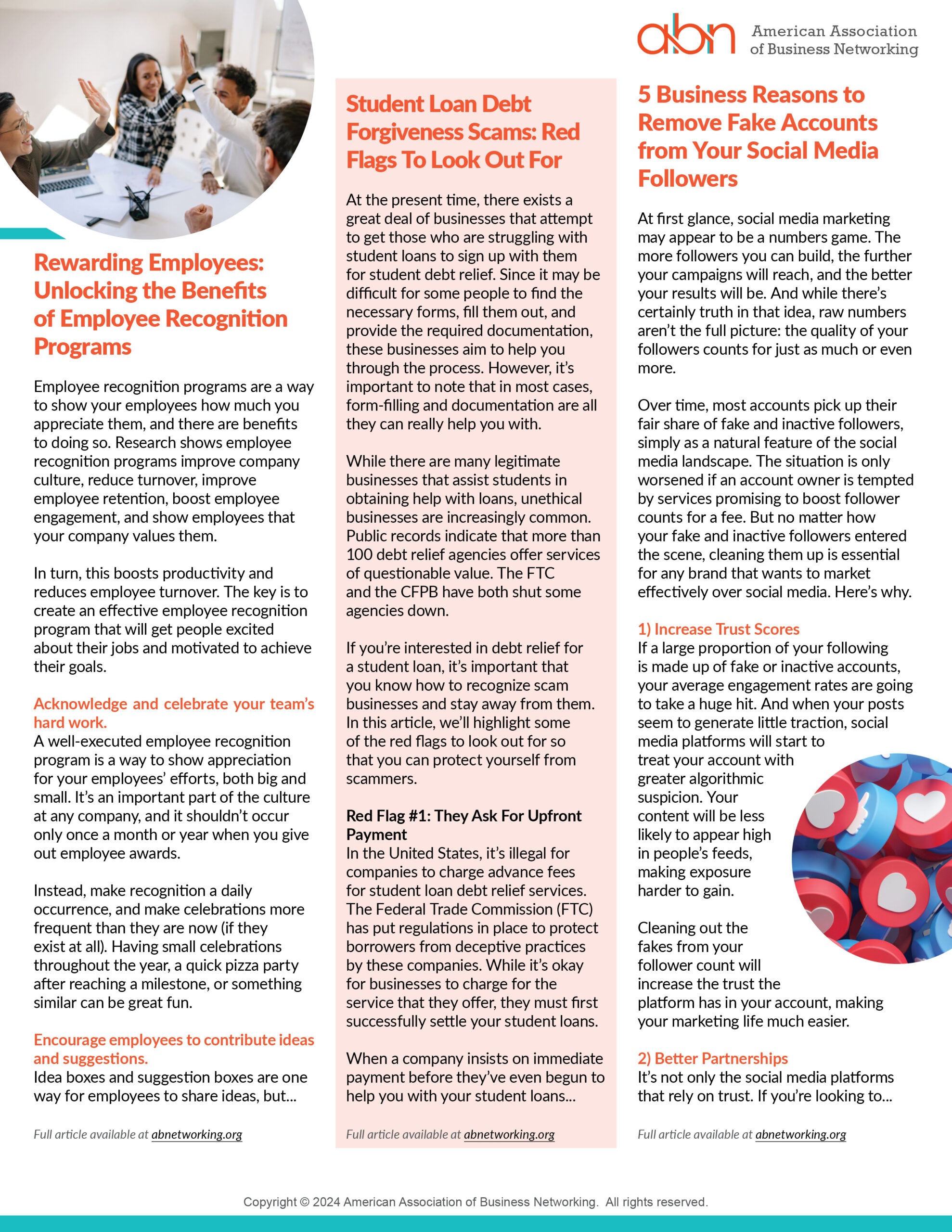ABN Newsletter Volume 7, Issue 3 April 2024



At first glance, social media marketing may appear to be a numbers game. The more followers you can build, the further your campaigns will reach, and the better your results will be. And while there’s certainly truth in that idea, raw numbers aren’t the full picture: the quality of your followers counts for just as much or even more.
Over time, most accounts pick up their fair share of fake and inactive followers, simply as a natural feature of the social media landscape. The situation is only worsened if an account owner is tempted by services promising to boost follower counts for a fee. But no matter how your fake and inactive followers entered the scene, cleaning them up is essential for any brand that wants to market effectively over social media. Here’s why.
If a large proportion of your following is made up of fake or inactive accounts, your average engagement rates are going to take a huge hit. And when your posts seem to generate little traction, social media platforms will start to treat your account with greater algorithmic suspicion. Your content will be less likely to appear high in people’s feeds, making exposure harder to gain.
Cleaning out the fakes from your follower count will increase the trust the platform has in your account, making your marketing life much easier.
It’s not only the social media platforms that rely on trust. If you’re looking to partner with another brand, either through influence or via mutual cross-marketing, large numbers of fakes in your audience will discourage any company that notices them.
The brands that are savvy enough to spot fakes are likely to be those who make the best use of social media and would therefore make the most lucrative partners. High fake numbers will close off these growth-producing options quickly and effectively.
Not all fake followers sit quietly in the background. Advanced bot networks attempt to simulate lifelike activity to fly under the automatic detection radar, but their interactions are clearly inauthentic to human eyes. If your brand’s timelines are packed with these poor-quality contributors, the negative impact on your customer credibility can be immense.
Accurate measurement of a campaign’s results is vital for effective social media marketing. Having a legion of fake followers makes it much more difficult to measure the true impact of your work. And when you don’t know in detail what’s working well, it’s much harder to reliably repeat your successes.
There’s no argument that fake news and manipulation have stormed social media in recent years. Most platforms are now taking active measures to reduce the number of click farms, fake accounts, and other undesirables polluting their networks.
If your brand is connected to high numbers of dubious accounts, you could easily be caught in the crossfire, and become collateral damage even if your content is of impeccable quality.
Finding fake accounts by hand can be time-consuming, but thankfully there are apps and tools available to automate the process on nearly every social platform. Try searching for phrases like ‘remove fake followers on Facebook’ or ‘identify bots on X’ to get a feel for what’s out there.
Once you’ve found the right tool for your needs, you’ll be given a list of suspicious accounts to evaluate. For each clear fake, block the account from your feed, and if you want to be thorough, report it to the platform as a bot account. It’ll take a while to fully clean your follower profile, but the long-term effects will be worth it.
All brands want more followers to produce better social media results, but quality is more important than sheer quantity. Taking the time to weed out and block fake followers can be just as effective for your bottom line as growing your roster of genuine, human followers.

At the present time, there exists a great deal of businesses that attempt to get those who are struggling with student loans to sign up with them for student debt relief. Since it may be difficult for some people to find the necessary forms, fill them out, and provide the required documentation, these businesses aim to help you through the process. However, it’s important to note that in most cases, form-filling and documentation are all they can really help you with.
While there are many legitimate businesses that assist students in obtaining help with loans, unethical businesses are increasingly common. Public records indicate that more than 100 debt relief agencies offer services of questionable value. The FTC and the CFPB have both shut some agencies down.
If you’re interested in debt relief for a student loan, it’s important that you know how to recognize scam businesses and stay away from them. In this article, we’ll highlight some of the red flags to look out for so that you can protect yourself from scammers.
In the United States, it’s illegal for companies to charge advance fees for student loan debt relief services. The Federal Trade Commission (FTC) has put regulations in place to protect borrowers from deceptive practices by these companies. While it’s okay for businesses to charge for the service that they offer, they must first successfully settle your student loans.
When a company insists on immediate payment before they’ve even begun to help you with your student loans, it’s a clear indication that something is amiss. Scammers often employ this tactic to exploit borrowers who are already struggling with debt, making false promises and then disappearing with their money.
To safeguard yourself from falling victim to such fraudulent schemes, always remember this cardinal rule: never pay upfront fees to a student loan debt relief company. Instead, seek assistance from trusted sources, like government programs or reputable nonprofit organizations, that offer legitimate help without requiring any payment upfront.
Some agencies promise to get you on something that they call the Obama student loan forgiveness program. While loan forgiveness programs were started under President Obama, there is no specific program that goes by that name.
Legitimate student loan assistance programs typically involve specific requirements and processes that take time to navigate. Companies claiming to offer overnight debt elimination or instant loan forgiveness often use such promises to lure in vulnerable borrowers. To protect yourself from potential scams, be cautious of any organization that seems too good to be true and remember that genuine assistance usually follows established procedures and timelines.
Be wary of student loan debt relief companies that employ aggressive sales tactics. Legitimate organizations focused on assisting borrowers with their student loans do not need to resort to high-pressure or pushy sales techniques. If you encounter a company that constantly pressures you to make quick decisions, sign contracts without adequate review, or insists on immediate payment, it’s a warning sign. Such aggressive tactics can be indicators of fraudulent operations attempting to exploit your financial vulnerability.
Legitimate assistance providers will offer information, answer your questions, and allow you the time you need to make informed decisions about managing your student loans. Always trust your instincts and proceed with caution when faced with aggressive sales tactics from these companies.
While legitimate student loan companies will require you to provide personal information like your social security number, it can be a red flag in some instances.
Here are some tips to keep in mind before providing sensitive information:
In general, it isn’t a good idea to go with a debt relief company that seems to offer anything more than a government program would, or in a shorter timeframe. All that an agency can really do for you is to apply for the government’s loan forgiveness programs on your behalf.
If you wish to avoid scams all together, you can go directly to the government’s student loan website.

Employee recognition programs are a way to show your employees how much you appreciate them, and there are benefits to doing so. Research shows employee recognition programs improve company culture, reduce turnover, improve employee retention, boost employee engagement, and show employees that your company values them.
In turn, this boosts productivity and reduces employee turnover. The key is to create an effective employee recognition program that will get people excited about their jobs and motivated to achieve their goals.
A well-executed employee recognition program is a way to show appreciation for your employees’ efforts, both big and small. It’s an important part of the culture at any company, and it shouldn’t occur only once a month or year when you give out employee awards.
Instead, make recognition a daily occurrence, and make celebrations more frequent than they are now (if they exist at all). Having small celebrations throughout the year, a quick pizza party after reaching a milestone, or something similar can be great fun.
Idea boxes and suggestion boxes are one way for employees to share ideas, but they don’t have to be limited to physical objects. You can also use an online forum or other medium for employees to submit ideas and suggestions for improvements.
Encourage staff members not only with words but also actions. If someone makes a suggestion you implement, recognize them publicly and privately. Remember to show your staff how much you value their hard work and dedication, both with your words and actions.
Reward employees for their contributions, acknowledge the hard work they do, and let them know how much their contributions matter, even if they’re not at the top of their field or making six figures per year. Reward programs help motivate employees by showing them that management appreciates them and that they’re valued as part of the team.
You might already have a rewards program in place, but if not, it’s time to think about what your employees would like as rewards. It can be anything from gift cards and certificates to plaques to even lunch with the CEO.
A successful recognition program will be simple and easy to implement. Keep these tips in mind:
Employee recognition programs are an effective way to motivate, cultivate, and retain top talent. They also help build a positive culture by encouraging employees to work harder and strive to be better.
You can use an employee recognition program to recognize any employee, not just top performers. It’s not always easy for managers or executives to recognize everyone on their teams equally when they’re so busy with their own responsibilities.
Plus, recognizing all types of people in your organization will help create a more inclusive environment where everyone feels valued and respected. That’s critical for companies aiming to achieve diversity goals.
There are many reasons to implement an employee recognition program, but the most important is that it will help you build a stronger culture. It’s also an effective way to motivate and retain top talent. If you want to create an environment where employees feel valued, this is the way forward.

Working from home sounds like a dream job to many people. One of the most appealing aspects of working from home is that you have the freedom to decide where, how, when, and how often you spend time earning a living. On the flipside, one of the biggest obstacles to overcome is how to stay productive while doing so.
It is all too easy to lose focus and succumb to distractions that, before you know it, end up taking up the majority of your day. If you find yourself spending more time daydreaming than working during your remote workday, or you are getting ready to make the transition to a work-from-home job, this list of four top tips will help keep your day profitably productive.
This tip is typically at the top of any list of suggestions for staying productive while working from home, with good reason. Any old space in your home won’t do when it comes to building a workspace that contributes to your daily productivity.
While staying in bed or lounging on the sofa in your pajamas sounds like a great way to “go to work” in anyone’s mind, those spaces should be the last place you plan to use as a home workspace.
The ideal workspace is a separate room with its own door that you can close and use as the dividing line between home and work. If that isn’t an option you can make a home office out of any area that can be designated your workspace, where you can set up and arrange the tools you need for work, and enforce a “do not disturb while working” policy for family, friends, children, and even your pets.
For those with the option, choosing to work whenever you can find the time is detrimental to any hopes you may have for a productive day. This is usually because you end up either not working at all or putting in much less time, energy, and effort toward achieving a full day’s work output.
Establishing a daily schedule for your work time and a routine to follow for each day significantly boosts productivity by providing structure and organization for your work-from-home habits. When you know you must “go to work” at a certain time and in a specific way, it is easier for you to prepare yourself mentally for the day ahead and stay on track for achieving work output goals.
Whether you are working at home for someone else or for yourself, you should have goals you need to achieve each day and tasks to complete to achieve those goals.
It often helps to put these things in writing to give you a black-and-white point of reference to refer to when you want to gauge your progress or get yourself back on track. You can also track your productivity in writing, as well. A simple time-tracking spreadsheet is an excellent way to record what you are actually getting done each day and how much time is being spent on each activity.
At the end of the day (or week), you can review your productivity tracking data and see if there are things you are doing to contribute to or take away from your overall success in staying productive. This kind of performance monitoring is also a good way to determine if there are goal-oriented tasks that are taking too much time or are not being allocated enough time, as well. This gives you a better idea of whether you need to allocate more or less time and effort, and in what ways, toward reaching the goals you set for yourself each day.
Workers who do their job at a company location do not have the luxury of snacking throughout their day, playing fetch with their dog, reading a book to their kids, surfing the internet, or watching a movie. Those are home-related activities and should be kept out of your work-from-home routine except during any break time you designate for yourself during each day.
Likewise, you should also never interrupt your at-home time with work activities. Avoid popping in your office and answering emails because you passed by or stopping to check in on projects before your designated work time. When you keep your work life separate from your home life as much as possible, it helps you stay focused on accomplishing your daily work goals and keeping your productivity level as high as possible.
Staying organized is a cornerstone of productivity when working from home. It serves as the glue that holds all the essential elements of remote work together, ensuring that you can maximize your efficiency and achieve your goals.
A well-organized workspace not only minimizes distractions but also helps create a conducive environment for focused work. But it’s not just about your physical workspace. Organization extends beyond your desk to your digital realm. Keeping digital files and documents neatly categorized and labeled helps you locate crucial information swiftly. Effective digital organization also means setting up an efficient email management system, using project management tools, and maintaining a clear calendar.
When your digital environment is structured, you can prioritize tasks effectively, avoid missed deadlines, and collaborate seamlessly with colleagues. Ultimately, staying organized while working from home allows you to minimize stress, maintain a sense of control over your workload, and devote more time and energy to productive, meaningful work.
These five tips will get you going in the right direction toward working from home and staying productive at the same time. You can also find many other great ideas to add to this list and make your home-bound work life the dream job you always hoped it would be.

As the job market continues to become increasingly competitive, it’s important to enhance your job skills in order to stay relevant and advance your career. Many people are deterred by the high cost of professional development, but it doesn’t have to break the bank. Here are five ways to upskill yourself on a tight budget.
An advantage of the internet is the wide variety of free educational resources available at your fingertips. From online courses to webinars and tutorials, there are countless resources you can use to learn new skills without spending a dime.
Some of the most popular online learning platforms include:
Utilizing the public library to enhance your job skills is a smart and cost-effective strategy. Here’s how you can make the most of this valuable resource:
Webinars and events have become indispensable tools for upskilling in today’s fast-paced professional landscape.
Webinars
One of the key advantages of webinars is their accessibility. Unlike traditional in-person seminars, webinars can be attended from anywhere in the world, eliminating geographical barriers. This means you have the ability to learn from experts and industry leaders that you may not have otherwise had access to. Webinars offer a fantastic opportunity to learn from the pros without having to leave your home
Many organizations and companies offer these webinars at a minimal cost–or even free. They may cover a variety of topics, from entrepreneurship and career development to digital literacy and social media basics. These can provide valuable insights and strategies to help you improve your skills and knowledge.
Events
Events may offer the same type of industry expert advice and upskilling capabilities as webinars. But beyond the educational aspect, events also offer networking opportunities. You’ll hear from and converse with successful business leaders and entrepreneurs, which can help you gain insights and advice that can help you take your career to the next level. Plus, the networking aspect of these events will help you make connections that could lead to future job opportunities.
Volunteering for skills-based projects can be a win-win situation for both you and the organization you’re volunteering for. You can gain valuable experience and develop new skills while also making a positive impact in your community. The benefits include:
Look for volunteer opportunities that align with your interests and skills. For example, if you’re interested in marketing, look for opportunities to help a local nonprofit with its social media or advertising campaigns.
Networking with other professionals in your field can be a powerful way to upskill yourself and stay up to date with the latest trends and best practices. A few ideas for networking:
Each of these methods can help you build a professional network, learn from others, and find opportunities for collaboration and growth, all while keeping expenses minimal.
Upskilling yourself on a tight budget is not only possible but can also be an enjoyable and fulfilling experience. By taking advantage of online and community resources, attending webinars and events, volunteering, and networking, you can inexpensively better your skillsets and set yourself up for professional success.

Your next job offer could arrive on your Facebook News Feed. You probably didn’t consider the ability of your Facebook profile to help you find jobs when you first created your account, but it’s real.
Facebook isn’t the newest social media platform out there, but it does attract an enthusiastic crowd – there are five new profiles created on the platform every second of every day (zephoria.com/top-15-valuable-facebook-statistics/). Millennials, those born in the two decades leading up to the year 2000, make up the largest part of the workforce, and are a generation that grew up on social media. While LinkedIn is more directly aimed at career-related social networking, it’s important to not ignore what Facebook is capable of in the employment arena.
If you like using Facebook, and if the idea of taking advantage of it to further your career seems interesting, consider the following tips.
Your first step to using Facebook to advance your career should be to conduct an audit of your profile to ensure that the content you have on it is well-suited to your career plans. It’s common for recruiters to go on Facebook or other social media to try to learn more about job applicants than they can from their resumes. As far back as 2015, according to a Jobvite Recruiter Nation survey (jobvite.com/wp-content/uploads/2015/09/jobvite_recruiter_nation_2015.pdf), more than 50 percent of recruiters reported using Facebook to research candidates. The state of your Facebook account matters a great deal to any plan to grow your career.
If your Facebook account has embarrassing old college photos or odd status updates from years ago, they won’t likely endear you to recruiters. You need to set aside time to work through your profile post by post to hide or delete anything that would appear out of place in a professional setting. You don’t need to take out everything that expresses your fun, personal side; it would just be a good idea to take aim at anything that you wouldn’t be comfortable having your grandparents see.
You can, additionally, make use of the privacy settings on your Facebook account to help ensure that content you’d like to keep private is only visible to friends.
People tend to avoid mixing personal social media with their professional lives. In reality, however, recruiters usually feel better about doing business with people that they like on a personal level. It’s important to stop seeing it as a risky venture to mix your personal Facebook space with your professional life.
Once you are done cleaning up your profile, you should be comfortable using Facebook to make connections with clients, or the professionals that you meet at the networking events that you attend. Subscribing on Facebook to receive the latest updates from professional contacts through text messages can be a good idea. While it can seem like excessive engagement, it can be a quick and effective way to establish relationships with select people who are important to your career. Staying updated through text messages can be far less effortful than making your way into the Facebook app and scrolling to find updates from important contacts.
Being a part of groups frequented by professionals in your niche is another way to stay tuned in to people who are important to your career.
Starting a group on Facebook can be a powerful way to reach out to other professionals who share your interest in a specific topic. In general, creating a group on Facebook is a better idea than creating a Facebook page. Facebook groups have a more robust presence on Facebook’s algorithms, compared to pages. When you create a Facebook group, you’re more likely to have Facebook’s algorithms push your content until it is seen by others.
To be meaningful to others, a group on Facebook needs to directly speak to the interests of the people on it. Thinking of topics that are likely to appeal to professionals in your industry niche is a good plan. You need to bring up interesting questions to draw industry professionals into a conversation, and do your homework so that you’re able to add value to the discussion — through posting relevant thoughts, or links. The more value you bring to a group, the more likely you are to build your professional reputation on Facebook.
In general, it makes sense to choose to post in the afternoons; this is the most common time for people to be on Facebook.
Many employers post information about open positions they have, in just the way that they post status updates. When you’re in the market for a new direction in your career, it can help to look at the Facebook pages of the employers that you most admire. Facebook is home to about 80 million businesses, and they often post information about career openings. If a position opens up with an employer you like, you can apply directly on their Facebook page. Unlike some job posting platforms, applying on Facebook is free.
It may seem like you need to make a huge commitment to Facebook to make use of it for your career, but it doesn’t actually take much time. All you need to do is to set aside a couple of hours each week to look at your group, make meaningful posts, reach out to important contacts, and look for jobs. You’ll network effectively this way, and lay a meaningful foundation for the future of your career.

You’ve got a business, and you want it to stand out. A tagline can help you do that. A clever and engaging tagline will help your customers recognize, remember and relate to your business. It will also help distinguish your company from your competitor and convey the message that your company has something unique or special to offer.
A good tagline should be a sentence or short phrase that sums up what your business does and what makes it different from the competition. It’s a one-liner you can use to over open conversations and networking connections. Plus, it’s an important tool for advertising and marketing. The best taglines are memorable but don’t have to be cute or clever. It should be easy to remember and make customers feel something.
Here are some tips for designing your brand’s tagline.
When you decide on a tagline, do some research on what other brands in your industry say about themselves. How do they talk about their products? What words do they use? Are there any common themes among them?
You can also look at how larger companies — like Apple, for example — construct their messaging. You might notice that Apple uses simple language and avoids jargon when describing new technology. This kind of clarity helps set them apart from other computer manufacturers who rely heavily on technical terms or unfamiliar vocabulary.
Get inspired by other companies but don’t copy. See how you can place a clever twist on their tagline approach and make it your own.
Keep it simple and focused on one benefit. Don’t try to be all things to all people, and don’t try to be clever. It’s not a contest, so don’t worry about being the funniest or most relevant. Instead, focus on what sets you apart from your competition. Trying to convey too many benefits in one tagline will only confuse people and weaken your message.
Some of the best taglines to be inspired by include:
Notice how short and memorable each is? If it takes them more than a few seconds for people to understand your tagline, or if they must read it several times to remember it, think of something new.
Focus groups offer an effective way to get an idea of what people think of your business before you spend money on branding. It’s a cheap method, too — just ask friends and family if they’ll be willing to answer a few questions about how they feel about your company. Write down every word they say that describes your business and see which ones are most common.
You might even set up focus groups for different audiences. Maybe ask friends for their opinion, but also set up interviews with people in your industry who could provide more insight into what makes them want to buy from you instead of someone else.
If a tagline is too trendy, it can become dated faster than you think. Take “Just do it,” for example. It’s an iconic phrase that has become synonymous with Nike’s brand identity. It’s a short and memorable tagline that should withstand the test of time.
That’s what you want. When you choose a tagline, you want it to be timeless — something catchy but classy that will appeal to your target market no matter what trends are hot now. Your clients should look back years from now and recognize your brand.
A timeless tagline will be relevant for your customers for years after its conception. For example, Apple has used the motto “Think Different” since 1997, and since then, it’s been used on everything from print ads to billboards. As long as Apple stays true to its message — that they’re different than other companies — the slogan will continue to work into the future.
Now that you have a tagline ready to go, it’s time to put it to work. Ensure you use your tagline in every aspect of your business, so people can see it everywhere and begin associating it with your brand. Use your tagline on social media posts, business cards, newsletters, and more. Put it to work for you.
A well-written tagline can be the difference between a mediocre business and a successful one. It can help you stand out from your competitors, attract new customers, and make a lasting impact on existing ones. Your tagline is the first thing people will see and hear when they encounter your brand. It’s crucial that it makes an impression, so take your time coming up with one.
Try some of these tips and see what works best for you and your business. Even if your tagline isn’t the most creative or catchy phrase in the world, it can be effective if it conveys what you do in a memorable way.